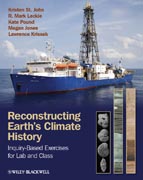
Reconstructing earth's climate history: inquiry-based exercises for lab and class
John, Kristen S.
Leckie, R. Mark
Pound, Kate
The context for understanding global climate change today lies in the recordsof Earths past. This is demonstrated by decades of paleoclimate research by scientists in organizations such as the Integrated Ocean Drilling Program (IODP), the Antarctic Geological Drilling Program (ANDRILL), and many others. The purpose of this book is to put key data and published case studies of past climate change at your fingertips, so that you can experience the nature of paleoclimate reconstruction. Using foundational geologic concepts you will explore awide variety of topics in this book, including: marine sediments, age determination, stable isotope paleoclimate proxies, Cenozoic climate change, climatecycles, polar climates, and abrupt warming and cooling events. You will evaluate published scientific data, practice developing and testing hypotheses, andinfer the broader implications of scientific results. It is our philosophy that addressing how we know is as important as addressing what we know about past climate change. Making climate change science accessible is the goal of thisbook. Readership: earth science students at a variety of levels studying paleoclimatology, oceanography, Quaternary science, or earth-system science. INDICE: The Authors Acknowledgments Book Introduction for Students and Instructors Geologic Timescale Chapter 1. Introduction to Paleoclimate Records. Part 1.1. Archives and Proxies Part 1.2. Owens Lake An Introductory Case Study of Paleoclimate Reconstruction Part 1.3. Coring Glacial Ice and Seafloor Sediments Chapter 2. Seafloor Sediments. Part 2.1. Sediment Predictions Part 2.2. Core Observations and Descriptions Part 2.3. Sediment Composition Part 2.4. Geographic Distribution and Interpretation Chapter 3. Microfossils and Biostratigraphy. Part 3.1. What are Microfossils? Why are they Important in Climate Change Science? Part 3.2. Microfossils in Deep-sea Sediments Part 3.3. Applicationof Microfossil First and Last Occurrences Part 3.4. Using Microfossil Datums to Calculate Rates Part 3.5. How Reliable are Microfossil Datums? Chapter 4. Paleomagnetism and Magnetostratigraphy. Part 4.1. Earths Magnetic Field Today and the Paleomagnetic Record of Deep-Sea Sediments Part 4.2. Paleomagnetism in Ocean Crust Part 4.3. Using Paleomagnetism to Test the Seafloor Spreading Hypothesis Part 4.4. The Geomagnetic Polarity Time Scale Chapter 5. CO2 as a Climate Regulator during the Phanerozoic and Today. Part 5.1. The Short Term GlobalCarbon Cycle Part 5.2. CO2 and Temperature Part 5.3. Recent Changes in CO2 Part 5.4. The Long-term Global Carbon Cycle, CO2, and Phanerozoic Climate History Chapter 6. The Benthic Foraminiferal Oxygen Isotope Record of Cenozoic Climate Change. Part 6.1. Introduction Part 6.2. Stable Isotope Geochemistry Part 6.3. A Biogeochemical Proxy Part 6.4. Patterns, Trends and Implications for Cenozoic Climate Chapter 7. Scientific Drilling in the Arctic Ocean: A Lesson onthe Nature of Science. Part 7.1. Climate Models and Regional Climate Change Part 7.2. Arctic Drilling Challenges and Solutions Part 7.3. The Need for Scientific Drilling Part 7.4. Results of the Arctic Drilling Expedition Chapter 8. Climate Cycles. Part 8.1. Patterns and Periodicities Part 8.2. Orbital Metronome Part 8.3. A Break in the Pattern Chapter 9. The Paleocene Eocene Thermal Maximum (PETM) Event. Part 9.1. The Cenozoic ´13C Record and an Important Discovery Part 9.2. Global Consequences of the PETM Part 9.3. Bad Gas: Is Methane toBlame? Part 9.4. How fast? How long? Part 9.5. Global Warming Today and Lessons from the PETM Chapter 10. Glaciation of Antarctica: The Oi1 Event. Part 10.1. Initial Evidence Part 10.2. Evidence for Global Change Part 10.3. Mountain Building, Weathering, CO2 and Climate Part 10.4. Legacy of the Oi1 Event: The Development of the Psychrosphere Chapter 11. Antarctica and Neogene Global Climate Change. Part 11.1. What do we Think we Know about the History of Antarctic Climate? Part 11.2. What is Antarcticas Geographic & Geologic Context? Part 11.3. Selecting Drillsites to Best Answer our Questions Chapter 12. Interpreting Antarctic Sediment Cores: A Record of Dynamic Neogene Climate. Part 12.1. What Sediment Facies are Common on the Ant
- ISBN: 978-0-470-65805-5
- Editorial: John Wiley & Sons
- Encuadernacion: Cartoné
- Páginas: 536
- Fecha Publicación: 13/02/2012
- Nº Volúmenes: 1
- Idioma: Inglés
